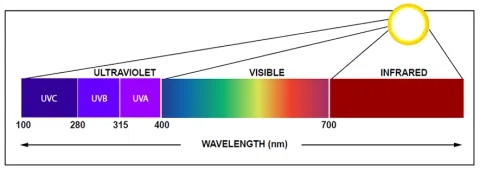Ultraviolet radiation – harmful or harmless?
Singapore’s recent hot weather and high temperatures between 25 and 34 Degree Celsius prompt us to put on our sunscreen and sunglasses diligently. The main reason of course, is to protect ourselves against the ultraviolet radiation from the sun.
What is ultraviolet and where does it come from?
Ultraviolet (UV) is an electromagnetic radiation with a wavelength from 10nm to 400nm, shorter than that of visible light but longer than X-rays. UV radiation constitutes about 10% of the total light output of the Sun, and is thus present in sunlight.

Ultraviolet radiation is made up of three types of rays – ultraviolet A, ultraviolet B, and ultraviolet C. Although ultraviolet C is the most dangerous type of ultraviolet light in terms of its potential to harm life on earth, it cannot penetrate earth's protective ozone layer. Therefore, it poses no threat to human, animal or plant life on earth.
Ultraviolet A and B, on the other hand, can penetrate the ozone layer to reach the surface of the planet. Suntans, freckling and sunburns are familiar effects of over-exposure to ultraviolet rays, along with a higher risk of skin cancer 1.
Artificial light that emits ultraviolet
In addition to the natural light from the sun, artificial light from tanning lamps contains ultraviolet A and ultraviolet B. Fluorescent lamps or Compact Fluorescent Lights (CFLs) that we commonly use in schools and commercial buildings do emit UV radiation but not all open CFLs produce significant UV emissions. They generate visible light because the bulb is coated with a layer of phosphor which glows when it comes into contact with UV radiation. Although most UV radiation stays within the bulb, some can escape into the environment which can potentially be a form of UV emission too.
Light-Emitting Diodes (LEDs), which are commonly used now, produce a very narrow spectrum of visible light without the losses to irrelevant radiation types (IR or UV) associated with conventional lighting, meaning that most of the energy consumed by the light source is converted directly to white light. Hence, the amount of UV emitted from LEDs is actually much less.
Can ultraviolet be beneficial?
Although ultraviolet light in large amounts can damage health, an acceptable amount of it can also maintain or improve health. When ultraviolet light strikes human skin, it triggers the production of vitamin D, which promotes the growth and formation of bones and teeth. Sunbathing is commonly used as an effective treatment for neonatal jaundice which is often seen in infants around the second day after birth as the sunlight helps to breakdown the bilirubin that causes jaundice. A recent study published from the Journal of the American Medical Association (JAMA) 8 has shown that children who spend more time outdoors have a reduced percentage in acquiring myopia and there was evidence to show that it also helps in slowing down myopia progression.
Hence, getting too much sun exposure can be harmful, but if done in moderation, ultraviolet is still essential and beneficial to us.
References:
1
Recent Blog Posts
- 19 Oct 2022
- 19 Oct 2022
- 19 Oct 2022
- 19 Oct 2022
- 19 Oct 2022
